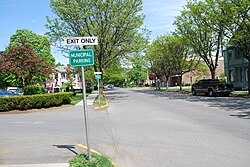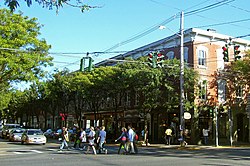New York State Route 308
New York State Route 308 (NY 308, Route 308) is a short road in Dutchess County, New York. The highway is 6.19 miles (9.96 km) long. It goes through mostly rural areas, and is usually used as a shortcut from U.S. Route 9 (US 9) to New York State Route 9G. The road passes several landmarks along its path. The road began its history in about 1685, when a group of Native Americans built the Sepasco Trail. This trail went from the Hudson River to Lake Sepasco, and followed the same path that currently exists as Route 308. The trail was there until 1802, when part of the Ulster and Delaware Turnpike was built over it. Route 308 was officially formed in 1930.
| Lua error in Module:Infobox_road/route at line 107: bad argument #1 to 'wikitext' (string or number expected, got boolean). | ||||
|---|---|---|---|---|
| Route information | ||||
| Length | 6.19 mi[1] (9.96 km) | |||
| Existed | 1930–present | |||
| Major junctions | ||||
| West end | Lua error in Module:Jct at line 204: attempt to concatenate local 'link' (a boolean value). in Rhinebeck | |||
| East end | Lua error in Module:Jct at line 204: attempt to concatenate local 'link' (a boolean value). in Milan | |||
| Lua error in package.lua at line 80: module 'Module:Road data/size' not found. | ||||
| Highway system | ||||
| ||||
Route description
Part of NY 308 is in the Rhinebeck Village Historic District, which is a 1,670 acres (680 ha) area that has 272 historical buildings. It was added to the National Register of Historic Places in 1979.[2] A well-known attraction is the Beekman Arms Inn, which is located at the corner of NY 308 and US 9. The inn was started in 1776,[3] and says it is one of the oldest inns within the United States.[4]
The road begins at US 9 in the village of Rhinebeck, which is 200 feet (61 m) above sea level.[5] To the south of here is a park, a small lake, and a cemetery. At this point, the Dutchess County Fairgrounds are north of Route 308. The highway goes to the east, and is called East Market Street. It soon leaves Rhinebeck, while it runs next to a small creek sometimes known as the Landsman Kill.[6]
The road intersects with County Route 101 and then turns to the north. It also intersects with Route 9G before it turns to the east into a rural area. In this area, Route 308 carries about 6,400 vehicles each day.[7] There are many small lakes around the road as it intersects with County Route 52 and turns to the northeast. NY 308 then travels west of Sepasco Lake before turning east again.[5] It ends at NY 199 in the town of Milan.[6]
History
The earliest people that lived in northern Dutchess County were the Mohicans. They were a Native American nation that came to the area about 3,000 years ago.[8] There were around 8,000 Mohicans during the time they first saw the Europeans. However, there were only 800 after the American Revolution.[9] Artifacts were found along the shore of Lake Sepasco, which is a small lake near NY 308. The artifacts included very old arrowheads, and are now being shown at a local museum.[10]
A smaller group of these Native Americans were known as the Sepasco Indians. This name was used for Native Americans in the Sepasco area, which is now known as Rhinebeck. The word Sepasco probably came from the tribe's word for "little river" or "stream", which is sepuus. After the Civil War, only a few of the Sepasco were left. The last Sepasco Indian died in 1867 in a hut near Lake Sepasco. By 1685, a trail known as the Sepasco Trail was formed by the Sepasco people. This trail started at the Hudson River and went east through the village of Rhinebeck. It ended at Lake Sepasco.[11] Part of the trail from Rhinebeck to Lake Sepasco follows about the same path that is today taken by Route 308.[11]
The trail was there until 1802, when a turnpike, a type of road, was built over it "for improving and making a road from the west line of the Town of Salisbury in the State of Connecticut to the Susquehannah [sic] River at or near the Town of Jericho".[12] The part of the new turnpike east of the Hudson River was sometimes known as the Ulster and Salisbury Turnpike. A plaque was placed in November 1922 at the Beekman Arms Inn. The sign marked the crossing of the Kings Highway (now called US 9) and the Ulster and Salisbury Turnpike.[13]
NY 308 itself was officially made during 1930.[14][15] The path of the road was changed a bit in the 1960s.[16]
Major intersections
The entire route is in Dutchess County.
| Location | Mile[1] | Roads intersected | Notes |
|---|---|---|---|
| Village of Rhinebeck | 0.00 | Lua error in Module:Jct at line 204: attempt to concatenate local 'link' (a boolean value). | |
| Town of Rhinebeck | 1.82 | Lua error in Module:Jct at line 204: attempt to concatenate local 'link' (a boolean value). | |
| Milan | 6.19 | Lua error in Module:Jct at line 204: attempt to concatenate local 'link' (a boolean value). | Hamlet of Rock City |
New York State Route 308 Media
References
- ↑ 1.0 1.1 "2008 Traffic Data Report for New York State" (PDF). New York State Department of Transportation. June 16, 2009. p. 291. Archived from the original (PDF) on July 21, 2011. Retrieved October 13, 2009.
- ↑ Marilyn Hatch. "Rhinebeck Village Walking Tour". Rhinebeck Chamber of Commerce. Archived from the original on 2007-01-07. Retrieved 2007-11-18.
- ↑ Historical Hotels of America. "Beekman Arms & Delamater Inn". National Trust for Historic Preservation. Archived from the original on 2011-05-17. Retrieved 15 May 2008.
- ↑ Harold Faber (1991). What's doing in: The Hudson Valley. https://query.nytimes.com/gst/fullpage.html?res=9D0CE3DC1038F937A25757C0A967958260&sec=&spon=&pagewanted=2. Retrieved 2008-07-20.
- ↑ 5.0 5.1 USGS (1993). "The National Map". TerraServer. Retrieved 2008-05-15.
- ↑ 6.0 6.1 Google, Inc. Google Maps [map]. Cartography by Tele Atlas. Retrieved on 1 March 2008.
- ↑ "Traffic Data Viewer". New York State Department of Transportation. 2006. Archived from the original on 2006-09-29. Retrieved 2008-07-16.
- ↑ "History". Milanconcerns.com. Retrieved 2008-07-14.
- ↑ "The Mohicans of Columbia County". Valatie Library. Archived from the original on 2008-05-18. Retrieved 2008-07-15.
- ↑ Nancy V. Kelly (2000). "October 2000 Chamber Line" (PDF). Rhinebeck Chamber of Commerce. Archived from the original (PDF) on 2006-05-20. Retrieved 2008-07-15.
- ↑ 11.0 11.1 Nancy V. Kelly (2000). "September 2000 Chamber Line" (PDF). Rhinebeck Chamber of Commerce. Archived from the original (PDF) on 2006-05-20. Retrieved 2008-07-15.
- ↑ State of New York, p. 113
- ↑ Ludy, p. 112
- ↑ Sun Oil Company. Road Map & Historical Guide - New York [map]. Cartography by Rand McNally and Company. (1935)
- ↑ United States Geological Survey. New York - Rhinebeck Quadrangle (southwestern portion) [map], 1 : 62,500, 15 Minute Series (Topographic). (1939) Retrieved on 21 April 2008.
- ↑ Sinclair. New York and Metropolitan New York [map]. Cartography by Rand McNally and Company. (1964)
Other reading
- Evan T. Pritchard (2002). Native New Yorkers: The Legacy of the Algonquin People of New York (1st ed.). San Francisco: Council Oak Books. ISBN 1571781072.
- State of New York (1804). Laws of the State of New York, Vol. III. Albany, New York: Charles R. and George Webster.
- Mary Robinson Sive (1998). Lost Villages: Historic Driving Tours in the Catskills. Delhi, New York: Delaware County Historical Association. ISBN 1892289008.
- Robert B. Ludy (1927). Historic Hotels of the World: Past and Present. Philadelphia: David McKay.
- Raymond C. Houghton (2003). A Revolutionary War Road Trip On Us Route 9: Spend a Revolutionary Day. Cyber Haus. ISBN 1931373124.
Other websites
| Wikimedia Commons has media related to Lua error in Module:Commons_link at line 62: attempt to index field 'wikibase' (a nil value).. |
- NY State Route 308 Ends Archived 2007-12-12 at the Wayback Machine
Lua error in Module:Attached_KML at line 224: attempt to index field 'wikibase' (a nil value).





